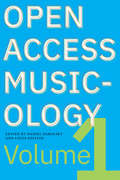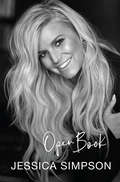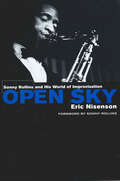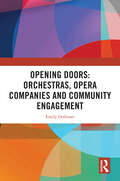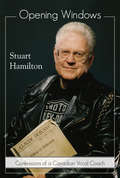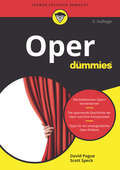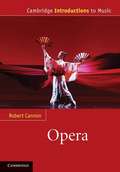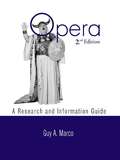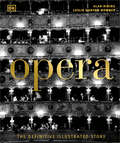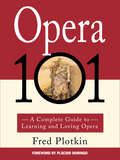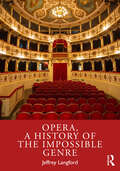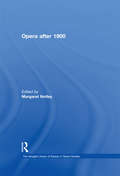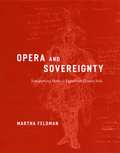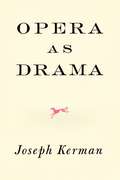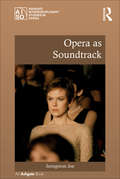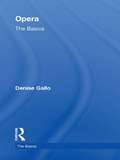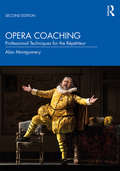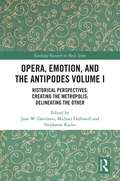- Table View
- List View
Open Access Musicology: Volume One
by Louis EpsteinIn the fall of 2015, a collection of faculty at liberal arts colleges began a conversation about the challenges we faced as instructors: Why were there so few course materials accessible to undergraduates and lay readers that reflected current scholarly debate? How can we convey the relevance of studying music history to current and future generations of students? And how might we represent and reflect the myriad, often conflicting perspectives, positions, and identities that make up both music’s history and the writers of history? Here we offer one response to those questions. Open Access Musicology is a collection of essays, written in an accessible style and with a focus on modes of inquiry rather than content coverage. Our authors draw from their experience as scholars but also as teachers. They have been asked to describe why they became musicologists in the first place and how their individual paths led to the topics they explore and the questions they pose. Like most scholarly literature, the essays have all been reviewed by experts in the field. Unlike all scholarly literature, the essays have also been reviewed by students at a variety of institutions for clarity and relevance. These essays are intended for undergraduates, graduate students, and interested readers without any particular expertise. They can be incorporated into courses on a range of topics as standalone readings or used to supplement textbooks. The topics introduce and explore a variety of subjects, practices, and methods but, above all, seek to stimulate classroom discussion on music history’s relevance to performers, listeners, and citizens.
Open Access Musicology: Volume Two
by Louis EpsteinOpen Access Musicology (OAM) publishes peer-reviewed, scholarly essays primarily intended to serve students and teachers of music history, ethno/musicology, and music studies. The constantly evolving collection ensures that recent research and scholarship inspires classroom practice. OAM essays provide diverse and methodologically transparent models for student research, and they introduce different modes of inquiry to inspire classroom discussion and varied assignments. Addressing a range of histories, methods, voices, and sounds, OAM embraces changes and tensions in the field to help students understand music scholarship. In service of our student- and access-centered mission, Open Access Musicology is a free collection of essays, written in an engaging style and with a focus on modes of inquiry rather than coverage of content. Our authors draw from their experience as scholars but also as teachers. They not only make arguments, but also describe why they became musicologists in the first place and explain how their individual paths led to the topics they explore. Like most scholarly literature, the essays have all been reviewed by experts in the field. Unlike most scholarly literature, the essays have also been reviewed by students at a variety of institutions for clarity and relevance. These essays are intended for undergraduates, graduate students, and interested readers without any particular expertise. They can be incorporated into courses on a range of topics as standalone readings, used to supplement textbooks, or read with an eye to new scholarly insights. The topics introduce and explore a variety of subjects, practices, and methods but, above all, seek to stimulate classroom discussion on music history’s relevance to performers, listeners, and citizens. Open Access Musicology will never pretend to present complete histories, cover all elements of a subject, or satisfy the agenda of every reader. Rather, each essay provides an opening to further contemplation and study. We invite readers to follow the thematic links between essays, pursue notes or other online resources provided by authors, or simply repurpose the essay’s questions into new and exciting forms of research and creativity. Volume 2 of OAM expands the disciplinary, topical, and geographical ranges of our endeavor, with essays that rely on ethnographic and music theoretical methods as well as historical ones. The essays in this volume touch on music from Europe, South America, and Asia, spanning the 16th century to the present. Throughout, the contributing authors situate music in political, religious, racial, economic, and other cultural and disciplinary contexts. This volume therefore expands what scholars generally mean when they refer to “musicology” and “music,” always with an eye toward relevance and accessibility.
Open Book
by Jessica SimpsonThe #1 New York Times BestsellerJessica reveals for the first time her inner monologue and most intimate struggles. Guided by the journals she's kept since age fifteen, and brimming with her unique humor and down-to-earth humanity, Open Book is as inspiring as it is entertaining.This was supposed to be a very different book. Five years ago, Jessica Simpson was approached to write a motivational guide to living your best life. She walked away from the offer, and nobody understood why. The truth is that she didn’t want to lie.Jessica couldn’t be authentic with her readers if she wasn’t fully honest with herself first.Now America’s Sweetheart, preacher’s daughter, pop phenomenon, reality tv pioneer, and the billion-dollar fashion mogul invites readers on a remarkable journey, examining a life that blessed her with the compassion to help others, but also burdened her with an almost crippling need to please. Open Book is Jessica Simpson using her voice, heart, soul, and humor to share things she’s never shared before.First celebrated for her voice, she became one of the most talked-about women in the world, whether for music and fashion, her relationship struggles, or as a walking blonde joke. But now, instead of being talked about, Jessica is doing the talking. Her book shares the wisdom and inspirations she’s learned and shows the real woman behind all the pop-culture cliché’s — “chicken or fish,” “Daisy Duke,” "football jinx," “mom jeans,” “sexual napalm…” and more. Open Book is an opportunity to laugh and cry with a close friend, one that will inspire you to live your best, most authentic life, now that she is finally living hers.
Open Sky: Sonny Rollins and His World of Improvisation
by Eric NisensonSonny Rollins is arguably the most influential tenor saxophonist that jazz has produced. He began his musical career at the tender age of eleven, and within five short years he was playing with the legendary Thelonius Monk. In the late forties (before his twenty-first birthday), Rollins was in full swing, recording with jazz luminaries such as Charlie Parker, Bud Powell, Max Roach, Art Blakey, Miles Davis, and Fats Navarro. He was hailed as the best jazz tenor saxophonist alive during the years 1955 to 1959, when he was credited with pioneering the use of 3/4-time in bop music.Today, forty years later, Rollins's onstage appearances are eagerly anticipated events, where his compelling sound reaches a whole new generation of listeners. Renowned jazz writer Eric Nisenson has penned a long-overdue look at one of jazz music's brightest and most enduring stars.
Opening Doors: Orchestras, Opera Companies and Community Engagement
by Emily DollmanWhat is the role of classical music in the 21st century? How will classical musicians maintain their relevance and purpose? This book follows the working activities of professional orchestral musicians and opera singers as they move off stage into schools, community centres, prisons, libraries, and corporations, engaging with their communities in new, rich ways through education and community engagement programmes. Key examples of collaborative partnerships between orchestras, opera companies, schools and music services in the delivery of music education are investigated, with a focus on the UK’s Music Hub system. The impact of these partnerships is examined, both in terms of how they inspire and foster the next generation of musicians as well as the extent to which they broaden access to quality music education. Detailed case studies are provided on the impact of classical music education programmes on social cohesion, health and wellbeing, and the education outcomes for students from low socio-economic communities. The implications for the future training of classical musicians are analysed, as are the new career paths for orchestral musicians and composers straddling performance and education. Opening Doors: Orchestras, Opera Companies and Community Engagement investigates the ways in which the classical music industry is reinventing its sense of purpose, never a more important or urgent pursuit than in the present decade.
Opening Windows: Confessions of a Canadian Vocal Coach
by Stuart Hamilton Lotfi MansouriA vocal coach who has been in the vanguard of classical music in Canada for more than six decades. Stuart Hamilton is a well-known Canadian musician who has been in the forefront of music in Canada for more than 60 years. Here, in this memoir, he recounts his sometimes hectic assault on the Canadian music world. Along the way, Hamilton encountered, as a vocal coach and accompanist, most of the great Canadian singers of the last half of the 20th century, and some international ones as well. For 27 years Hamilton was an erudite and funny personality on CBC’s Saturday Afternoon at the Opera. He has appeared across Canada with such beloved artists as Lois Marshall, Maureen Forrester, Richard Margison, and Isabel Bayrakdarian. In Opening Windows, Hamilton takes the reader into his confidence on numerous matters that have influenced musical life in Canada for decades.
Oper für Dummies (FÜr Dummies)
by David Pogue Scott SpeckDieses Buch entführt Sie in die Welt der kraftvollen Stimmen, volltönenden Orchester, fesselnden Dramen, aufwändigen Bühnenbilder und prächtigen Kostüme! Von finsteren Königinnen, dem Pakt mit dem Teufel, verarmten Künstlern bis zur wahren Liebe und der trickreichen Ehefrau, die ihren Gatten aus dem Kerker rettet - in der Oper ist alles zu finden. "Oper für Dummies" nimmt Ihnen die Furcht vor der fremden, manchmal ein wenig snobistisch erscheinenden Welt der Oper. Das Buch lehrt Sie die "Opernsprache" und führt Sie anhand der Operngeschichte durch vergangene Jahrhunderte zu den besten Opern, den berühmtesten Komponisten und den Opern-Schauplätzen von gestern und heute.
Opera
by Robert CannonWhat is opera and how does it work? How has this dramatic form developed and what is its relevance in the modern world? Perfect for music students and opera-goers, this introductory guide addresses these questions and many more, exploring opera as a complete theatrical experience. Organised chronologically and avoiding technical musical terminology, the book clearly demonstrates how opera reflected and reacted to changes in the world around it. A special feature of the volume is the inclusion of illustrative tables throughout. These provide detailed, easy to follow analysis of arias, scenes and acts; visual guides to historical movements; and chronologies relating to genres and individual composers' works. Overall, the book fosters an understanding of opera as a living form as it encounters and uses material from an ever expanding repertoire in time, place and culture.
Opera: A Research and Information Guide (Routledge Music Bibliographies)
by Guy A. MarcoOpera is the only guide to the research writings on all aspects of opera. This second edition presents 2,833 titles--over 2,000 more than the first edition--of books, parts of books, articles and dissertations with full bibliographic descriptions and critical annotations. Users will find the core literature on the operas of 320 individual composers and details of operatic life in 43 countries. All relevant works through to November 1999 have been considered, covering more than fifteen years of literature since the first edition was published.
Opera: The Definitive Illustrated History
by Alan Riding Leslie Dunton-DownerExperience the passion and drama of the world&’s greatest operas with this sumptuously illustrated visual guide.Immerse yourself in more than 400 years of the world&’s most celebrated operas and discover the fascinating stories behind them. Explore the lives of singers such as Maria Callas, Luciano Pavarotti, and Jonas Kaufmann. Meet composers like Mozart, Wagner, and Britten, and the librettists with whom they collaborated to create the magical blend of words and music that make up opera.From its origins in the 17th-century courts of Italy to live screenings in public spaces today, Opera: The Definitive Illustrated Story follows the history of opera from Monteverdi&’s L'Orfeo in 1607, to Cosi fan Tutte, La Bohème, and modern operas such as Brokeback Mountain. It explains musical terminology, traces historical developments, and sets everything in a cultural context.This awe-inspiring opera book further features:-Includes all of the most important operas from the Renaissance to the 21st century-Profiles the key composers, librettists, performers, and companies, with details of their lives, works, and influence-Arranged in chronological order to show the evolution of the genre-Clear, informative explanation of musical terminology and different types of operaThis book revels in the sets and costumes that make up the grand spectacle of opera. It also explores the great opera houses of the world, such as La Scala, Milan, the Met in New York, and the Sydney Opera House. Opera: The Definitive Illustrated Story is the essential book for anyone who wants to understand and enjoy the constantly evolving world of this beloved art form.Did you know that there are more than 25,000 opera performances per year worldwide? Opera: The Definitive Illustrated Story can be regarded as the most lavishly illustrated history of opera currently available, covering all of the most important operas from the Renaissance to the 21st century, and is completely global in scope. A must-have volume for opera buffs, whether as a gift or self-purchase, if you&’re a music lover looking for an accessible introduction to opera, then this is the book for you!
Opera: A Beginner's Guide (Beginner's Guides)
by Alexandra WilsonOpera is often perceived to be characterised by excessive passions, sumptuous costumes, lavish sets, and ill-mannered divas. In reality, operas address the most fundamental and universal human concerns - love, death, jealousy, greed and power. In this timeless introduction, Alexandra Wilson rescues the art form from fading into insignificance and reveals the reasons behind its lasting appeal.
Opera 101: A Complete Guide to Learning and Loving Opera
by Fred PlotkinOpera is the fastest growing of all the performing arts, attracting audiences of all ages who are enthralled by the gorgeous music, vivid drama, and magnificent production values. If you've decided that the time has finally come to learn about opera and discover for yourself what it is about opera that sends your normally reserved friends into states of ecstatic abandon, this is the book for you. Opera 101 is recognized as the standard text in English for anyone who wants to become an opera lover--a clear, friendly, and truly complete handbook to learning how to listen to opera, whether on the radio, on recordings, or live at the opera house. Fred Plotkin, an internationally respected writer and teacher about opera who for many years was performance manager of the Metropolitan Opera, introduces the reader (whatever his or her level of musical knowledge) to all the elements that make up opera, including: A brief, entertaining history of opera; An explanation of key operatic concepts, from vocal types to musical conventions; Hints on the best way to approach the first opera you attend and how to best understand what is happening both offstage and on; Lists of recommended books and recordings, and the most complete traveler's guide to opera houses around the world. The major part of Opera 101 is devoted to an almost minute-by-minute analysis of eleven key operas, ranging from Verdi's thunderous masterpiece Rigoletto and Puccini's electrifying Tosca through works by Mozart, Donizetti, Rossini, Offenbach, Tchaikovsky, and Wagner, to the psychological complexities of Richard Strauss's Elektra. Once you have completed Opera 101, you will be prepared to see and hear any opera you encounter, thanks to this book's unprecedentedly detailed and enjoyable method of revealing the riches of opera.
Opera, a History of the Impossible Genre
by Jeffrey LangfordOpera, a History of the Impossible Genre offers an accessible and chronological survey of opera.Beginning in the 16th century, each chapter hones its focus on a representative opera and composer, and provides discussion on historical and political context. With further reading lists, key term definitions, and composer biographies to support learning, this book covers the fundamental elements of the genre, including: subject matter, musical structure, aria and ensemble forms, singing styles, orchestra, and the structure of the libretto. The book will also help readers develop an appreciation of opera as a form of musical entertainment, which, despite seemingly insurmountable financial, philosophical, and artistic hurdles, has overcome the “impossible” to become one of the most popular and thrilling types of music heard on stage today.Opera, a History of the Impossible Genre is an approachable undergraduate textbook for students of opera and survey courses.
Opera Acts
by Karen HensonOpera Acts explores a wealth of new historical material about singers in the late nineteenth century and challenges the idea that this was a period of decline for the opera singer. In detailed case studies of four figures - the late Verdi baritone Victor Maurel; Bizet's first Carmen, Célestine Galli-Marié; Massenet's muse of the 1880s and '90s, Sibyl Sanderson; and the early Wagner star Jean de Reszke - Karen Henson argues that singers in the late nineteenth century continued to be important, but in ways that were not conventionally 'vocal'. Instead they enjoyed a freedom and creativity based on their ability to express text, act and communicate physically, and exploit the era's media. By these and other means, singers played a crucial role in the creation of opera up to the end of the nineteenth century.
Opera after 1900
by Margaret NotleyThe articles reprinted in this volume treat operas as opera and from some sort of critical angle; none of the articles uses methodology appropriate for another kind of musical work. Additional criteria used in selecting the articles were that they should not have been reprinted widely before and that taken together they should cover an extended array of significant operas and critical questions about them. Trends in Anglophone scholarship on post-1900 opera then determined the structure of the volume. The anthologized articles are organized according to the place of origin of the opera discussed in each of them; the introduction, however, follows a thematic approach. Themes considered in the introduction include questions of genre and reception; perspectives on librettos and librettists; words, lyricism, and roles of the orchestra; and modernism and other political contexts.
Opera and Modern Spectatorship in Late Nineteenth-Century Italy
by Alessandra CampanaAt the turn of the twentieth century Italian opera participated to the making of a modern spectator. The Ricordi stage manuals testify to the need to harness the effects of operatic performance, activating opera's capacity to cultivate a public. This book considers how four operas and one film deal with their public: one that in Boito's Mefistofele is entertained by special effects, or that in Verdi's Simon Boccanegra is called upon as a political body to confront the specters of history. Also a public that in Verdi's Otello is subjected to the manipulation of contemporary acting, or one that in Puccini's Manon Lescaut is urged to question the mechanism of spectatorship. Lastly, the silent film Rapsodia satanica, thanks to the craft and prestige of Pietro Mascagni's score, attempts to transform the new industrial medium into art, addressing its public's search for a bourgeois pan-European cultural identity, right at the outset of WWI.
Opera and Sovereignty: Transforming Myths in Eighteenth-Century Italy
by Martha FeldmanPerformed throughout Europe during the 1700s, Italian heroic opera, or opera seria, was the century’s most significant musical art form, profoundly engaging such figures as Handel, Haydn, and Mozart. Opera and Sovereignty is the first book to address this genre as cultural history, arguing that eighteenth-century opera seria must be understood in light of the period’s social and political upheavals. Taking an anthropological approach to European music that’s as bold as it is unusual, Martha Feldman traces Italian opera’s shift from a mythical assertion of sovereignty, with its festive forms and rituals, to a dramatic vehicle that increasingly questioned absolute ideals. She situates these transformations against the backdrop of eighteenth-century Italian culture to show how opera seria both reflected and affected the struggles of rulers to maintain sovereignty in the face of a growing public sphere. In so doing, Feldman explains why the form had such great international success and how audience experiences of the period differed from ours today. Ambitiously interdisciplinary, Opera and Sovereignty will appeal not only to scholars of music and anthropology, but also to those interested in theater, dance, and the history of the Enlightenment.
Opera and the Political Imaginary in Old Regime France
by Olivia BloechlFrom its origins in the 1670s through the French Revolution, serious opera in France was associated with the power of the absolute monarchy, and its ties to the crown remain at the heart of our understanding of this opera tradition (especially its foremost genre, the tragédie en musique). In Opera and the Political Imaginary in Old Regime France, however, Olivia Bloechl reveals another layer of French opera’s political theater. The make-believe worlds on stage, she shows, involved not just fantasies of sovereign rule but also aspects of government. Plot conflicts over public conduct, morality, security, and law thus appear side-by-side with tableaus hailing glorious majesty. What’s more, opera’s creators dispersed sovereign-like dignity and powers well beyond the genre’s larger-than-life rulers and gods, to its lovers, magicians, and artists. This speaks to the genre’s distinctive combination of a theological political vocabulary with a concern for mundane human capacities, which is explored here for the first time. By looking at the political relations among opera characters and choruses in recurring scenes of mourning, confession, punishment, and pardoning, we can glimpse a collective political experience underlying, and sometimes working against, ancienrégime absolutism. Through this lens, French opera of the period emerges as a deeply conservative, yet also more politically nuanced, genre than previously thought.
Opera As Drama
by Joseph KermanPassionate, witty, and brilliant,Opera as Dramahas been lauded as one of the most controversial, thought-provoking, and entertaining works of operatic criticism ever written. First published in 1956 and revised in 1988,Opera as Dramacontinues to be indispensable reading for all students and lovers of opera.
Opera as Soundtrack (Ashgate Interdisciplinary Studies in Opera)
by Jeongwon JoeFilmmakers' fascination with opera dates back to the silent era but it was not until the late 1980s that critical enquiries into the intersection of opera and cinema began to emerge. Jeongwon Joe focusses primarily on the role of opera as soundtrack by exploring the distinct effects opera produces in film, effects which differ from other types of soundtrack music, such as jazz or symphony. These effects are examined from three perspectives: peculiar qualities of the operatic voice; various properties commonly associated with opera, such as excess, otherness or death; and multifaceted tensions between opera and cinema - for instance, opera as live, embodied, high art and cinema as technologically mediated, popular entertainment. Joe argues that when opera excerpts are employed on soundtracks they tend to appear at critical moments of the film, usually associated with the protagonists, and the author explores why it is opera, not symphony or jazz, that accompanies poignant scenes like these. Joe's film analysis focuses on the time period of the post-1970s, which is distinguished by an increase of opera excerpts on soundtracks to blockbuster titles, the commercial recognition of which promoted the production of numerous opera soundtrack CDs in the following years. Joe incorporates an empirical methodology by examining primary sources such as production files, cue-sheets and unpublished interviews with film directors and composers to enhance the traditional hermeneutic approach. The films analysed in her book include Woody Allen’s Match Point, David Cronenberg’s M. Butterfly, and Wong Kar-wai’s 2046.
Opera: The Basics (The Basics)
by Denise GalloOpera: The Basics offers an excellent introduction to four centuries of opera. Its easy to follow sections explore topics including: the origins of opera basic terminology the history of major opera genres including: serious opera, comic opera, semi-serious opera and vernacular opera. With key notes, discography and videography, this is the ideal book for students and interested listeners who want to learn more about this important musical genre.
Opera Coaching: Professional Techniques for the Répétiteur
by Alan MontgomeryOpera Coaching: Professional Techniques for the Répétiteur, Second Edition, is an update to the first practical guide for opera coaches when working with opera singers to help them meet the physical and vocal demands of a score in order to shape a performance. Opera coaching remains a mystery to many musicians. While an opera coach (or répétiteur) is principally tasked with ensuring singers sing the right notes and words, the coach’s purview extends well beyond pitches and pronunciation. The opera coach must have a full understanding of human physiognomy and the human voice, as well as a knowledge of the many languages used in Western vocal music and over four centuries of opera repertoire – all to recognize what must happen for success when a singer steps on stage. NEW to this second edition: New and updated chapters throughout, featuring new discussions on large ensembles, twenty-first-century demands, and more. Deeper investigation of the styles of and problems posed by particular operas. Revised chapter structure that allows for an expanded and progressive emphasis on technical work. Modern singers have bemoaned the scarcity of good vocal coaches and conductors – those who understand voices and repertoire alike. Opera Coaching: Professional Techniques for the Répétiteur, Second Edition, demystifies the role of the opera coach, outlining the obstacles facing both the opera singer and the coach who seeks to realize the performer’s full potential.
Opera, Emotion, and the Antipodes Volume I: Historical Perspectives: Creating the Metropolis; Delineating the Other (Routledge Research in Music)
by Jane W. DavidsonThere can be little doubt that opera and emotion are inextricably linked. From dramatic plots driven by energetic producers and directors to the conflicts and triumphs experienced by all associated with opera’s staging to the reactions and critiques of audience members, emotion is omnipresent in opera. Yet few contemplate the impact that the customary cultural practices of specific times and places have upon opera’s ability to move emotions. Taking Australia as a case study, this two-volume collection of extended essays demonstrates that emotional experiences, discourses, displays and expressions do not share universal significance but are at least partly produced, defined, and regulated by culture. Spanning approximately 170 years of opera production in Australia, the authors show how the emotions associated with the specific cultural context of a nation steeped in egalitarian aspirations and marked by increasing levels of multiculturalism have adjusted to changing cultural and social contexts across time. Volume I adopts an historical, predominantly nineteenth-century perspective, while Volume II applies historical, musicological, and ethnological approaches to discuss subsequent Australian operas and opera productions through to the twenty-first century. With final chapters pulling threads from the two volumes together, Opera, Emotion, and the Antipodes establishes a model for constructing emotion history from multiple disciplinary perspectives.
Opera, Emotion, and the Antipodes Volume II: Applied Perspectives: Compositions and Performances (Routledge Research in Music)
by Jane W. Davidson Michael Halliwell Stephanie RockeThere can be little doubt that opera and emotion are inextricably linked. From dramatic plots driven by energetic producers and directors to the conflicts and triumphs experienced by all associated with opera’s staging to the reactions and critiques of audience members, emotion is omnipresent in opera. Yet few contemplate the impact that the customary cultural practices of specific times and places have upon opera’s ability to move emotions. Taking Australia as a case study, this two-volume collection of extended essays demonstrates that emotional experiences, discourses, displays and expressions do not share universal significance but are at least partly produced, defined, and regulated by culture. Spanning approximately 170 years of opera production in Australia, the authors show how the emotions associated with the specific cultural context of a nation steeped in egalitarian aspirations and marked by increasing levels of multiculturalism have adjusted to changing cultural and social contexts across time. Volume I adopts an historical, predominantly nineteenth-century perspective, while Volume II applies historical, musicological, and ethnological approaches to discuss subsequent Australian operas and opera productions through to the twenty-first century. With final chapters pulling threads from the two volumes together, Opera, Emotion, and the Antipodes establishes a model for constructing emotion history from multiple disciplinary perspectives.
The Opera Fanatic: Ethnography of an Obsession
by Claudio E. BenzecryThough some dismiss opera as old-fashioned, it shows no sign of disappearing from the world’s stage. So why do audiences continue to flock to it? Given its association with wealth, one might imagine that opera tickets function as a status symbol. But while a desire to hobnob with the upper crust might motivate the occasional operagoer, for hardcore fans the real answer, according to The Opera Fanatic, is passion—they do it for love. Opera lovers are an intense lot, Claudio E. Benzecry discovers in his look at the fanatics who haunt the legendary Colón Opera House in Buenos Aires, a key site for opera’s globalization. Listening to the fans and their stories, Benzecry hears of two-hundred-mile trips for performances and nightlong camp-outs for tickets, while others testify to a particular opera’s power to move them—whether to song or to tears—no matter how many times they have seen it before. Drawing on his insightful analysis of these acts of love, Benzecry proposes new ways of thinking about people’s relationship to art and shows how, far from merely enhancing aspects of everyday life, art allows us to transcend it.
